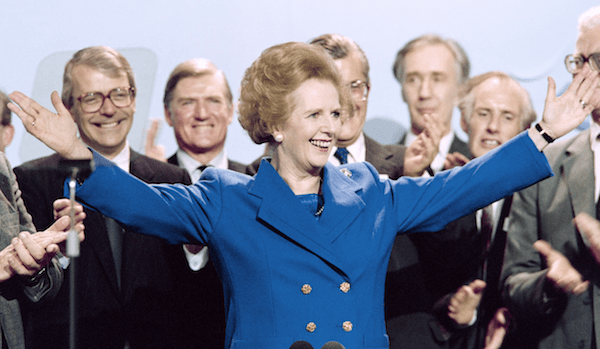Why on earth would we want to put up a statue of Margaret Thatcher in Parliament Square? That’s the question that a number of politicians are asking after the possibility arose once again at the weekend. ‘Steady on,’ said Nicola Sturgeon. Labour’s Chris Bryant was (unsurprisingly, perhaps) rather more verbose. ‘What Mrs Thatcher did to communities like the Rhondda deserves recognition in the annals of callousness; not another statue.’ Down with the Tory fool behind the suggestion who just cannot stop reminiscing about the 1980s.
Except the suggestion came not from a Conservative but a Liberal Democrat MP. Jo Swinson wrote a piece in the Mail on Sunday in which she describes witnessing the very policies that Bryant is so angry about:
‘I grew up in the West of Scotland during the 1980s. Local steelmaking and coal mining industries were hit hard by Thatcher’s policies.
‘Her disastrous decision to use Scotland as a guinea pig for the implementation of the poll tax is firmly lodged in my memory, along with the protests it generated.’
So why, after using the very argument that opponents of a Thatcher statue make, does Swinson actually want one? Her point is that there are currently no statues of women at all in Parliament Square, and that adding just one, commemorating Millicent Fawcett, is hardly sufficient. Thatcher’s achievements as Swinson grew up left her in no doubt that a woman can be Prime Minister, even if, as she says ‘I now spend a significant amount of my time trying to find policy solutions to change the unethical corporate behaviour that Thatcherism unleashed’.
There is already a statue of Thatcher inside Parliament: it’s in the Members’ Lobby, which isn’t often open to the public. But it’s also one of just a handful of depictions of women in the Palace: there’s Elizabeth I round the corner, and a very small portrait relief of Nancy Astor, the first woman to take her seat in the House of Commons, on the Committee Corridor. Mostly, though, the walls are lined with men, some of whom were highly divisive, and many of whom we have learned more about how not to do politics than anything else. These scant references to political women do have an impact. I am a little younger than Swinson, and can only remember John Major popping up on the television when I was a child, which means I grew up assuming that politics was for men. These initial impressions can create misconceptions that mean women don’t go near politics: I learned recently that while it takes a couple of days between a man being asked whether he would like to be an MP and his application landing with the party headquarters, it takes a woman six months to complete the same process. There is also strong anecdotal evidence that even people involved in selection panels (who are therefore normally highly politically involved) automatically think of a man when asked to think of what an MP would look like.
Swinson argues that while we commemorate men who we disagree with, we don’t do the same with a woman like Thatcher. This unconscious bias is certainly a strong factor in the noisy opposition to just one public statue. But there’s something else at play here, which is the increasing discomfort with depictions of our past in general.
We don’t seem to want to accept that the past is another country where they do things differently, or if we do, we would like it to be a country that no-one ever talks about or acknowledges. Statues of divisive men, monuments to movements that caused some people great pain, and buildings funded by the proceeds of the slave trade are all over the United Kingdom. Of course we are uneasy that our ancestors did such things, but just as any mention of Thatcher is always swiftly accompanied by the word ‘divisive’ and a much wordier argument about her legacy, we have previously been able to contextualise these monuments as part of a past that not everyone is fully comfortable with. The discomfort we might feel on seeing, for instance, the Wills Memorial Building in Bristol, which is a beautiful building named after a member of a family that used slaves to farm tobacco, is actually an important part of ensuring that such things don’t happen again. Our whole society, far beyond physical structures, is built on memories and old ways of doing things.
Margaret Thatcher will always be Britain’s first female Prime Minister. She will always be a politician with a colossal legacy. Nothing will change those things. Nothing, by the way, will change the fact that there are MPs in Parliament today who are inspired by Thatcher in a wholly positive way, or indeed the fact that there was applause from the crowds outside St Paul’s at her funeral. We can’t control our past, and we can’t control the way other people feel differently about our past, either. No number of statues will stop her being a divisive name whose legacy people will always argue about. Similarly, no moratorium on statues will change what has been.
That’s why Swinson is right to disagree vehemently with Thatcher’s legacy while wanting a statue of her. How much better would it be if those who go to great efforts to try to prevent us commemorating our first female Prime Minister instead used their precious time to try to change the parts of her legacy that they disagree with? You cannot change the past, but at least a statue might motivate you to do something about the present.







Comments